

|
Charger Standards Converge
|
Toyota Joins the Inductive Charger CampIn a June press conference, GM and Toyota announced that they had come to agreement on a standardized inductive charging system. Previously, Nissan had committed to using the GM inductive system. The agreement, however, came at the cost of switching over to a new inductive paddle with a smaller form factor to accommodate anticipated smaller cars for the foreign markets. Backward compatibility was not neglected, however. Existing GM EV1, Chevy S10, and Nissan cars will be accommodated with a slip-on adapter for the charger paddle.
|
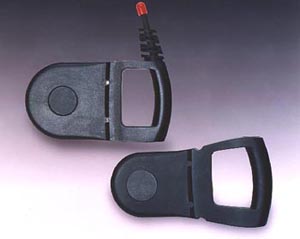 Closeup comparing the current inductive
charging paddle (top) and the new standard paddle.
Photo provided by Kris Trexler.
Closeup comparing the current inductive
charging paddle (top) and the new standard paddle.
Photo provided by Kris Trexler.
|
||||||||
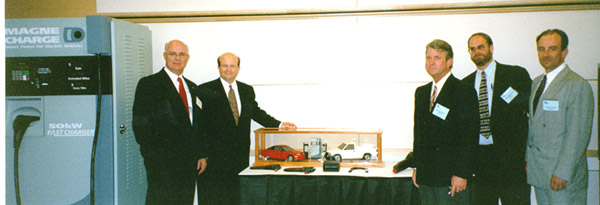
Recent press conference announcing the GM-Toyota agreement to standardize inductive charging. The U-shaped adapter visible on the table allows current EV1's to use chargers with the new paddle. Photo provided by John Cox. |
|||||||||
Why Standardize?
|
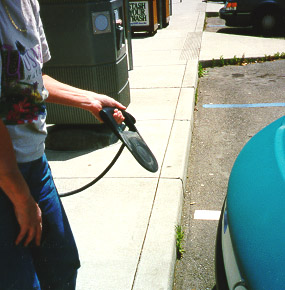 Citicar inductive charger paddle. Photo provided by
Tom Dowling.
Citicar inductive charger paddle. Photo provided by
Tom Dowling.
|
||||||||
|
Most drivers have probably heard that for conductive
connections, there are numerous varieties of 240V
connectors. But do you know that there are at least
two inductive systems already installed? Take a
close look at the photo at right. That's NOT an EV1
paddle! It's a Citicar inductive paddle.
Check out the photos below from the Walnut Creek BART station to see what the whole confused charger mess looks like all in one place!
|
|||||||||
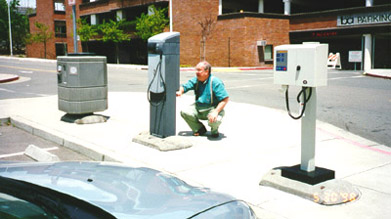
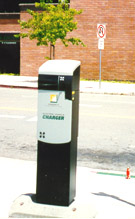 BART station covers all of the bases!
BART station covers all of the bases!At left, Sacramento EV1 driver Tom Dowling checks out the charger situation at the Walnut Creek BART station. Photos provided by Tom Dowling.
|
|
On the left, the large cement pedestal houses a
Hubbell 240 Twistlock conductive connector. In the
middle, Tom checks out the EV1 charger look-alike which
is actually an inductive charger for the Citicar. At
the right is a conductive station for the Honda/Ford
vehicles.
Not shown - a conductive connection station with a standard 120V socket as well as NEMA 14-50 (240V) sockets! |
Also at the Walnut Creek BART station is a familiar sight for EV1 drivers -- the Magnecharge inductive charger (GM/Nissan compatible). |
|
|
|||||||||

|
Return to the EV1 Club Home Page |
||||||||